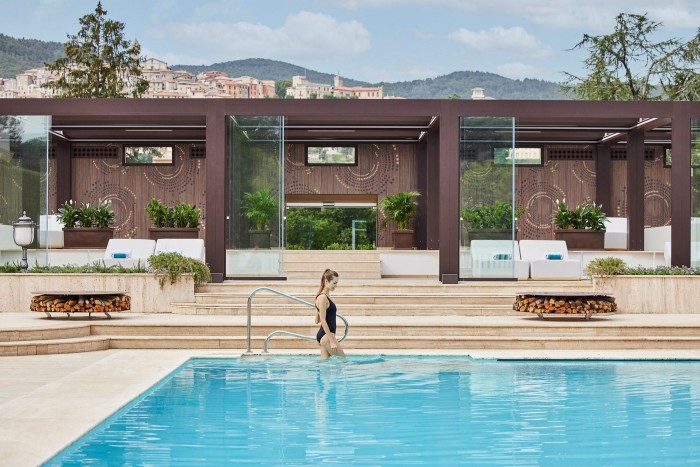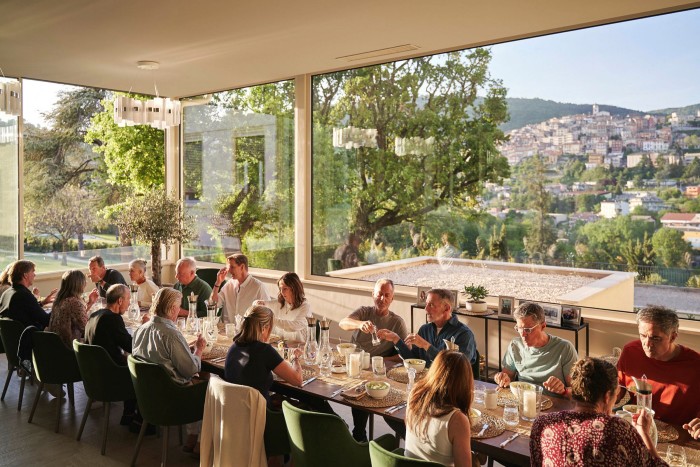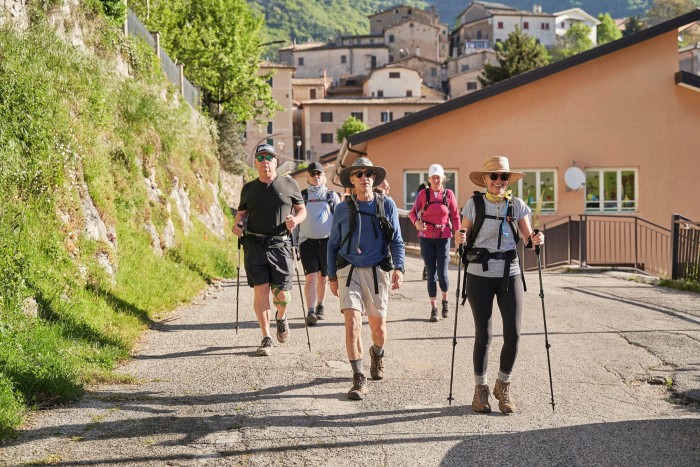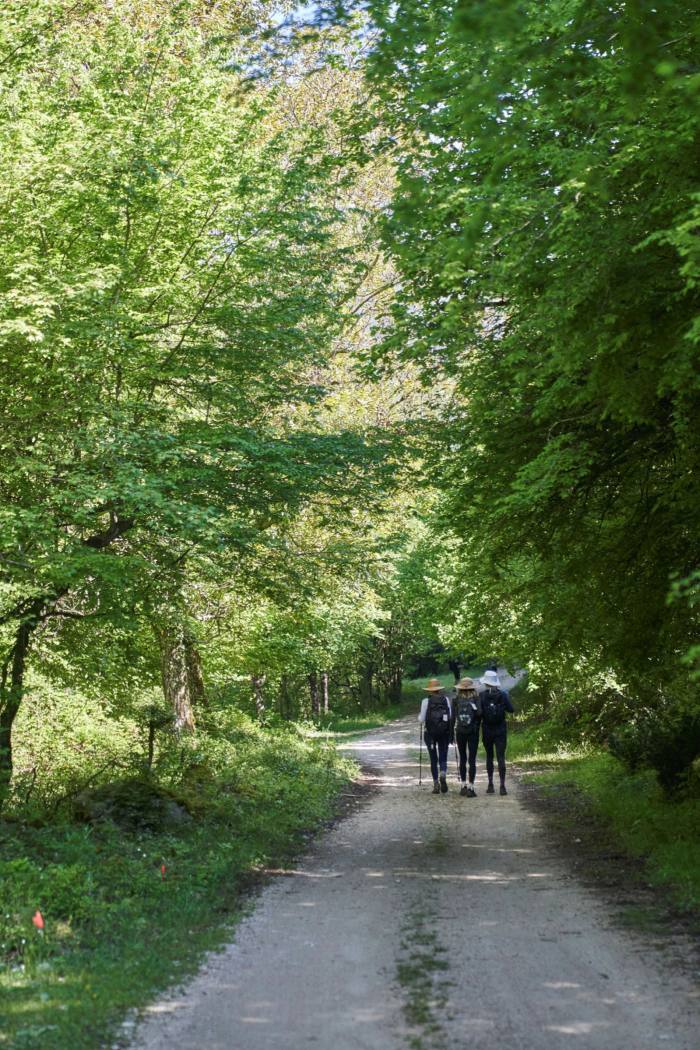It’s 5.30am and the phone rings in our room at the Palazzo Fiuggi. “Good morning, this is Viviana,” says a gentle Italian voice. “It’s time to get up.” My husband mutters: “I thought this was a holiday?”
The Ranch Italy is a holiday that takes itself very seriously, and expects guests to do so too. Nestling in the Apennines an hour east of Rome, this is a new outpost of the Ranch Malibu, a celebrated health retreat that helps stressed-out Hollywood types to “reset and refocus”. It’s a combination of luxury boot camp, medical diagnostics, plant-based diets, daily massages and mountain hikes. Fans are reputed to include Michelle Obama.
That first morning, barely had I staggered down to the 6am stretching class than I was whisked upstairs again to have my blood drawn before breakfast. I was too tired to protest. There was a stoic sense of camaraderie among the 12 guests as we breakfasted together at the long, wooden table we used for every meal, with a spectacular view of the medieval town of Fiuggi. The age range was 29 to 72, with a big span of fitness. Most were American or Australian, and several were veterans of the Ranch Malibu. So addictive is the Malibu retreat that half of its guests are repeat visitors. About 70 per cent are women, which was the case for our group.


After a distressingly small breakfast of unsweetened granola, no coffee in sight, it was a relief to be promised a snack to take on our 10-mile morning hike. But when little bags were delivered into our outstretched hands containing only six almonds, there was no doubt that the big theme of this week was going to be mindful eating. I was terrified of dropping a single almond, so chewed each one thoughtfully while swigging water from my CamelBak, part of the Ranch’s required packing list. Another guest pocketed three of her almonds, in case worse was to come. Nor does such privation come cheap: in fact, the Ranch charges more than $1,000 per day.
The philosophy is, broadly, that plant-based, gluten-free diets can reduce inflammation and the risk of disease. There is some evidence for this. When I was researching my book Extra Time: Ten Lessons for an Ageing World, I became fascinated by the Okinawans, islanders who live longer than most populations and have a much lower incidence of cancer and heart disease than westerners.

They are physically active every day, eat a lot of vegetables and few or no processed foods. They also stick to what they call “hara hachi bu” — eating until the belly is only eight parts full. This chimes with experiments that show calorie restriction can extend life by triggering ancient circuits that evolved to protect our cells through drought and famine. A rhesus monkey called Canto has lived to the human equivalent of 140 by eating two-thirds less than a normal monkey, but no one’s asked him if he’s enjoyed it.
At 1,400 calories a day, the Ranch menu is nowhere near as drastic, although it still felt challenging. Four weeks before we arrived we received the pre-programme that urged us to steadily give up alcohol, meat, coffee and sugar, and to increase our water intake and step count. I was very glad, on arrival, that I had managed to follow quite a lot of it, to cushion the shock.
All these thoughts disappeared on the first hike. The trails were spectacular. The Apennines look more like Switzerland than Lazio, with jagged escarpments rising out of wild-flower meadows and vast ancient forests where we padded through carpets of dead leaves. The inclines were steep and often twisting; we were guided by little flags that had been planted earlier. We each had a walkie-talkie, something I had assumed was American health-and-safety overkill but which freed us up to walk alone if we wanted — and which proved vital later in the week, when one member of the group got lost.

The A-types among us forged ahead, despite our guides encouraging us over the walkie-talkies to “look around, enjoy the scenery, listen out for the cuckoo, and drink — water, water water”. I pounded up, sometimes slipping on bare rock, keeping up with my husband and an Australian, who were the fittest.
Driving back from one hike, my husband asked the young woman driver, jokingly, if we could stop for amaretti. She seemed minded to agree, until the manager shouted fiercely “No stopping!” We slumped back in our seats as our convoy of blacked-out Mercedes vans swept through the hills like a cult.
The hikes took place every morning, followed by lunch at the hotel, an afternoon nap that was essential to offset the early start, then a luxury massage, yoga and strength training. The meals were delicious, and ingenious. On one day we ate a cauliflower crust “pizza” with cheese made from macadamia nuts; on another, a white bean tart with a sunflower seed crust. The lack of eggs came as a shock, though — I worried I was missing too much protein.

The average Ranch guest loses between three and six kilos in a week, and some guests had signed up hoping to lose even more. We all started to talk about food incessantly. One veteran reminisced in detail about the banana bread she makes using the Ranch Malibu cookbook as we sweated together up a hill. I would have killed for just the banana. At times I felt so weak I had to focus simply to put the right things in my rucksack in preparation for the next day, before crashing into bed.
One evening, my husband spotted some fig trees by the hotel pool. We reached for the fruit and bit into them, feeling childishly guilty and hoping no one would see — only to spit them out in disappointment, as they weren’t ripe.
Ranch founders Alex and Sue Glasscock grew up in Texas and Michigan respectively and moved to California in 1987. He worked in property development and commercial mortgage financing, she in landscape and interior design, before they set up the Ranch Malibu in 2010. “We noticed our friends back home were getting heavier and more lethargic,” says Alex. “We thought: we don’t want to get like that.” They had experimented with low-fat food but then discovered it was packed with refined sugar, so hired a chef to create tasty vegan recipes. After attending a wellness retreat in 2004, they decided to create their own, opting for a highly structured programme, says Sue, because “it’s so rare to be able to feel immersed and relieved of having to make decisions”.



My transformation happened on the Wednesday morning. I was walking downhill through a silent forest, threading my way round bushes and rocks, far away from the rest of the group. Pale orange butterflies flitted through dappled sunlight and there was nothing to hear except the rhythmic tramp of my own feet. I felt euphoric, light-headed and utterly at one with the world. That day, the broccoli soup tasted exquisite and I felt extra-grateful for the massage.
I didn’t recapture quite that pure sense of joy again, but I did start to feel less concerned about winning. The staff tried hard to dampen our competitive spirits by making the hikes about time rather than distance covered. Some of us got blisters in our newly purchased hiking boots. Everyone was enduring in different ways, which increased our warmth towards our comrades-in-arms. Two guests were staying on for two weeks, and another had booked in for three.
The only jarring note was when we went for the results of our medicals. The Ranch Italy is centred around the five-star Palazzo Fiuggi, a recently refurbished spa hotel based around the springs of healing Fiuggi water. Its swimming pools are divine, but the whole thing was a contrast to the boho Ranch style, where we sat around the table saying what we felt grateful for. The white-clad doctors exuded a rather fake bonhomie, compared with the earnest sincerity of the Ranch staff in their black T-shirts. The tests included a complete blood count, cholesterol and thyroid levels, and was pretty extensive; but most guests in our group were wealthy enough to have similar tests done regularly and felt a little patronised.

At the end of the week I had lost 2kg and narrowed my waist by 3cm. The first two days back at work I felt light-headed and slow. Yet I was intrigued to find that I had no desire to stoke up my energy with sugar or bread. I was far more interested in eating vegetables and grains, and have remained so. I’m drinking coffee again, but only one cup a day rather than my previous three. Two weeks since our return, I feel calm and energetic and clear-headed despite having had a full-on schedule. And people have been commenting on how good I look, which is gratifying.
Is it for everyone? No. The hikes are tough and you do need to be fit. If you want to lounge around a pool and have your blood checked, there are numerous luxury “medi-spas” out there that will be more suitable. But would I do it again? Definitely. For me, it felt like an ideal cross between a spa, complete with indulgent massages, and Be Military Fit, an outdoor boot camp I do in London parks, where the members of the group urge each other on.
The next time, though, I would avoid going to work on the following Monday morning: the Sunday-to-Sunday Ranch experience demands some recovery time. I would also be religious about following the 30-day pre-programme. The only thing I would change is the crack-of-dawn starts, which Californians may love rather more than Europeans. By day four we had worked out how to prepare so fast for the morning sessions that we could stay in bed a little beyond the 5.30am reveille. We unplugged the hotel phone — and the staff were kind enough not to mention it.
Camilla Cavendish is an FT columnist
Details
Camilla Cavendish was a guest of the Ranch Italy (theranchmalibu.com). An eight-day retreat costs $9,100 per person for double occupancy and $10,650 for a single room, including activities, massages, diagnostic testing, all meals and airport transfers
Follow @ftweekend on Twitter to find out about our latest stories first





More Stories
Healthy Meal Ideas: Green Herbs For Laksa Soup And Pasta Dishes
What Wise Guys Eat
Historical Sites in Italy – Bologna